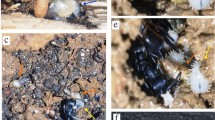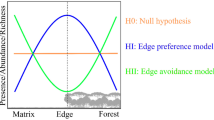Abstract
To explore the difference in pollen harvest between the western honey bee Apis mellifera and a native eastern honey bee A. cerana in the Zoige alpine meadows in the northeastern part of the Qinghai-Tibetan Plateau, we investigated species diversity of the harvested pollen and the amount of harvested pollen per bee for both species, and calculated the niche overlap (in terms of similarity in harvested pollen) between the two bee species during the flowering season from June to August 2016. Results showed that the species diversity of the harvested pollen was indistinguishable between the two bee species. Nevertheless, A. mellifera carried more (although not significant) pollens per bee than A. cerana. Moreover, pollen composition differed between the two bee species: A. mellifera mainly foraged on Anemone rivularis, Saussurea nigrescens and Anemone trullifolia, while A. cerana foraged on Anemone rivularis, Stellera chamaejasme, and Pedicularis longiflora. Consistently, the niche overlap between the two honeybee species was particularly small in several observations. Our results indicate a niche separation in pollen resource between the two honeybee species in a Tibetan alpine meadow.
Similar content being viewed by others
References
Badano EI, Vergara CH (2011) Potential negative effects of exotic honey bees on the diversity of native pollinators and yield of highland coffee plantations. Agricultural & Forest Entomology 13: 365–372. https://doi.org/10.1111/j.1461-9563.2011.00527.x
Bernard E, Vaissière S, Bradleigh V (1994) Pollen morphology and its effect on pollen collection by honey bees, Apis Mellifera L. (Hymenoptera: Apidae), with special Reference to Upland Cotton, Gossypium Hirsutum L. (Malvaceae). Grana 33: 128–138. https://doi.org/10.1080/00173139409428989
Celebrezze T, Paton DC (2004) Do introduced honeybees (Apis mellifera, Hymenoptera) provide full pollination service to bird-adapted Australian plants with small flowers? An experimental study of Brachybma ericoides, (Epacridaceae). Austral Ecology 29(2): 129–136. https://doi.org/10.1111/j.1442-9993.2003.01328.x
Cody ML (1974) Competition and the structure of bird communities. Princeton University Press.
Cortopassi-Laurino M (1982) Divisäo de recursos tròficos entre abelhas sociais, principal-mente em Apis mellifera Linnè e Trigona spimped Fabricius (Apidae, Hymenoptera). PhD Thesis, Instituto de Biociências, Universidade de Säo Paulo, Säo Paulo, Brazil.
Crane E (1990) Bees and beekeeping: science, practice and world resources. Heinemann Newnes.
Dick CW, Etchelecu G, Austerlitz F (2003) Pollen dispersal of tropical trees (Dinizia excelsa: Fabaceae) by native insects and African honeybees in pristine and fragmented Amazonian rainforest. Molecular Ecology 12: 753–764. https://doi.org/10.1046/j.1365-294X.2003.01760.x
Dupont YL, Hansen DM, Valido A, Olesen JM (2004) Impact of introduced honey bees on native pollination interactions of the endemic Echium wildpretii, (Boraginaceae) on Tenerife, Canary Islands. Biological Conservation 118: 301–311. https://doi.org/10.1016/j.biocon.2003.09.010
England PR, Beynon F, Ayre DJ, et al. (2001) A molecular genetic assessment of mating-system variation in a naturally bird-pollinated shrub: contributions from birds and introduced honeybees. Conservation Biology 15: 1645–1655. https://doi.org/10.1046/j.1523-1739.2001.00236.x
Erdtman G (1960) The Acetolysis Method. A Revised Description. Svensk Botanisk Tidskrift 54:561–564.
Erdtman G. (1966) Pollen morphology and plant taxonomy. New York.
Feng M, Ramadan H, Han B, Yu F, Li J (2014) Hemolymph proteome changes during worker brood development match the biological divergences between western honey bees (Apis mellifera) and eastern honey bees (Apis cerana). BMC Genomics 15: 563–576. https://doi.org/10.1186/1471-2164-15-563
Goras G, Tananaki C, Dimou M, et al. (2016) Impact of honeybee (Apis mellifera) density on wild bee foraging behavior. Journal of Apicultural Science 60: 49–62. https://doi.org/10.1515/JAS-2016-0007
Gross CL, Mackay D (1998) Honeybees reduce fitness in the pioneer shrub Melastoma affine, (Melastomataceae). Biological Conservation 86: 169–178. https://doi.org/10.1016/S0006-3207(98)00010-x
Gross CL (2001) The effect of introduced honeybees on native bee visitation and fruit-set in Dillwynia juniperina, (Fabaceae) in a fragmented ecosystem. Biological Conservation 102: 89–95. https://doi.org/10.1016/S0006-3207(01)00088-x
Hansen DM, Olesen JM, Jones CG (2002) Trees, birds and bees in Mauritius: exploitative competition between introduced honey bees and endemic nectarivorous birds? Journal of Biogeography 29: 721–734. https://doi.org/10.1046/j.1365-2699.2002.00720.x
Hu ZW, Zhang XW, Yang J, et al. (2016) An investigation of pollinators and niche analysis in Xiangyun Basin during winter. Chinese Journal of Ecology 35: 3353–3359. (in Chinese)
Huang HC, Yang GH, Chen SB (1963) Primary research on biological characteristics of Chinese honeybees. Scientia Agriculture Sinica 1: 43–44. (in Chinese)
Kajobe R (2006) Pollen foraging by Apis mellifera, and stingless bees Meliponula bocandei, and Meliponula nebulata, in Bwindi Impenetrable National Park, Uganda. African Journal of Ecology 45: 265–274. https://doi.org/10.1111/j.1365-2028.2006.00701.x
Kaur P, Mishra A, Lal D (2016) Honey characterization based on physicochemical parameters using GIS techniques: A case study in selected states of Northern India. Journal of Food Processing and Technology, 7(626), 2. https://doi.org/10.4172/2157-7110.1000626
Kato M, Shibata A, Yasui T, Nagamasu H (1999) Impact of introduced honeybees, Apis mellifera, upon native bee communities in the Bonin (Ogasawara) Islands. Researches on Population Ecology 41: 217–228. https://doi.org/10.1007/s101440050025
Levins R (1968) Evolution in changing environments: some theoretical explorations. Princeton University Press.
Li G, Liu Y, Frelich LE, Sun S (2011) Experimental warming induces degradation of a Tibetan alpine meadow through trophic interactions. Journal ofApplied Ecology 48: 659–667. https://doi.org/10.1111/j.1365-2664.2011.01965.x
Liu YJ, Zhao TR, Zhao FY (2013) Melissopalynology and trophic niche of Apis cerana and Apis mellifera ligustica in Yunnan Province of Southwest China. Chinese Journal of Applied Ecology 24: 205–210. (in Chinese)
Liu ZG, Chen C, Guo HK, Lyu LP, Shi W (2016) Mortality in Apis mellifera L. colonies in China from 2009 to 2013. Acta Ecologica Sinica 36: 3005–3012. (in Chinese)
Miller M, Aplet G (1992) Biological control: a little knowledge is a dangerous thing. Rutgers Law Review 45: 285–334.
Mitchell RJ, Karron JD, Holmquist KG, et al. (2004) The influence of Mimulus ringens, floral display size on pollinator visitation patterns. Functional Ecology 18: 116–124. https://doi.org/10.1111/j.1365-2435.2004.00812.x
Moritz RFA, Härtel S, Neumann P (2005) Global invasions of the western honeybee (Apis mellifera) and the consequences for biodiversity. Ecoscience 12: 289–301. https://doi.org/10.2980/i1195-6860-12-3-289.1
Mu J, Peng Y, Xi X, et al. (2014) Domesticated honey bees evolutionarily reduce flower nectar volume in a Tibetan lotus. Ecology 95: 3161–3172. https://doi.org/10.1890/13-2055.1
Li XQ, Peng J, Long ZZ, Zhen DG (2009) Flowering phenology of alpine meadow plant community in eastern Qinghai-Tibetan Plateau. Chinese Journal of Ecology 28: 2202–2207. (in Chinese)
Schoener TW (1968) The Anolis lizards of Bimini: resource partitioning in a complex fauna. Ecology 49: 704–726. https://doi.org/10.2307/1935534
Singh R, Kumar S, Kashyap PL, et al. (2015) Evaluation of pesticide toxicity at their field recommended doses to honeybees, Apis cerana and A. mellifera through laboratory, semi-field and field studies. Chemosphere 119: 668–674. https://doi.org/10.1016/j.chemosphere.2014.07.039
Sun SG, Huang SQ, Guo YH (2013) Pollinator shift to managed honeybees enhances reproductive output in a bumblebee-pollinated plant. Plant Systematics & Evolution 299:139–150. https://doi.org/10.1007/s00606-012-0711-8
Tan K, Yang S, Wang ZW, et al. (2012) Differences in foraging and broodnest temperature in the honey bees Apis cerana, and A. mellifera. Apidologie 43: 618–623. https://doi.org/10.1007/s13592-012-0136-y
Thomson D (2004) Competitive interactions between the invasive European honey bee and native bumble bees. Ecology 85: 458–470. https://doi.org/10.1890/02-0626
Thorp DW, Wenner AM, Barthell JF (2000) Pollen and nectar resource overlap among bees on Santa Cruz Island. MBC Applied Environmental Sciences 261–267.
Trapnell DW, Hamrick JL (2006) Floral display and mating patterns within populations of the neotropical epiphytic orchid, Laeliarubescens (Orchidaceae). American Journal of Botany 93: 1010–1018. https://doi.org/10.2307/4125589
Vaughton G (1996) Pollination disruption by European honeybees in the Australian bird-pollinated shrub grevillea barklyana (Proteaceae). Plant Systematics & Evolution 200: 89–100. https://doi.org/10.1007/bf00984750
Wang QF, Li WS, Zhang QM, et al. (2003) The natural mating interference between Apis cerana and A. mellifera. Entomological Knowledge 40: 164–167. https://doi.org/10.1007/bf02974893
Wu X, Sun S (2010) The roles of beetles and flies in yak dung removal in an alpine meadow of eastern Qinghai-Tibetan Plateau. Ecoscience 17: 146–155. Pollen and nectar resource overlap among bees on Santa Cruz Island. https://doi.org/10.2980/17-2-3319
Wu X, Duffy JE, Reich PB, Sun S (2011) A brown-world cascade in the dung decomposer food web of an alpine meadow: effects of predator interactions and warming. Ecological Monographs 81: 313–328. https://doi.org/10.1890/10-0808.1
Yang GH (2005) Harm of introducing the western honeybee Apis mellifera L. to the Chinese honeybee Apis cerana F. and its ecological impact. Acta Entomologica Sinica 48: 401–406. (in Chinese)
You XL, Zhang DS, Xi JB, et al. (2009) Comparative study on three Hibiscus Syracuse cultivars characteristics of nectar secretion, and pollen presentation and entomophiles pollination. Acta Agriculturae Shanghai 25: 81–86. (in Chinese)
Yu LS, Zou YD, Cao YF, Bi SD, et al. (2008) Comparative study on the niches of Apis mellifera ligustica and Apis cerana cerana. Acta Ecologica Sinica 28: 4575–4581. (in Chinese)
Zu P, Schiestl FP (2017) The effects of becoming taller: direct and pleiotropic effects of artificial selection on plant height in Brassica rapa. The Plant Journal 89: 1009–1019. https://doi.org/10.1111/tpj.13440
Acknowledgements
We thank XI Xinqiang and ZHONG Xintong for field assistance. The manuscript was financially supported by the National Natural Science Foundation of China (31470482) and the Fundamental Research Funds for the Central Universities.
Author information
Authors and Affiliations
Corresponding author
Electronic Supplementary Material
Rights and permissions
About this article
Cite this article
Hu, L., Wu, Xw. The difference in pollen harvest between Apis mellifera and Apis cerana in a Tibetan alpine meadow. J. Mt. Sci. 16, 1598–1605 (2019). https://doi.org/10.1007/s11629-018-5245-2
Received:
Revised:
Accepted:
Published:
Issue Date:
DOI: https://doi.org/10.1007/s11629-018-5245-2




